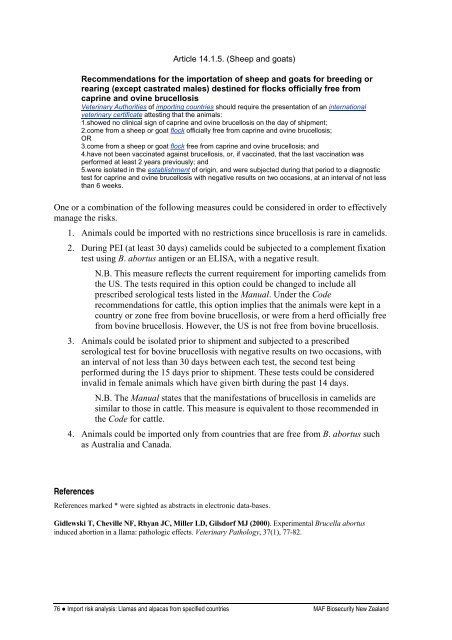Import risk analysis: Llamas (Lama glama) and alpacas (Vicugna ...
Import risk analysis: Llamas (Lama glama) and alpacas (Vicugna ...
Import risk analysis: Llamas (Lama glama) and alpacas (Vicugna ...
Create successful ePaper yourself
Turn your PDF publications into a flip-book with our unique Google optimized e-Paper software.
Article 14.1.5. (Sheep <strong>and</strong> goats)<br />
Recommendations for the importation of sheep <strong>and</strong> goats for breeding or<br />
rearing (except castrated males) destined for flocks officially free from<br />
caprine <strong>and</strong> ovine brucellosis<br />
Veterinary Authorities of importing countries should require the presentation of an international<br />
veterinary certificate attesting that the animals:<br />
1.showed no clinical sign of caprine <strong>and</strong> ovine brucellosis on the day of shipment;<br />
2.come from a sheep or goat flock officially free from caprine <strong>and</strong> ovine brucellosis;<br />
OR<br />
3.come from a sheep or goat flock free from caprine <strong>and</strong> ovine brucellosis; <strong>and</strong><br />
4.have not been vaccinated against brucellosis, or, if vaccinated, that the last vaccination was<br />
performed at least 2 years previously; <strong>and</strong><br />
5.were isolated in the establishment of origin, <strong>and</strong> were subjected during that period to a diagnostic<br />
test for caprine <strong>and</strong> ovine brucellosis with negative results on two occasions, at an interval of not less<br />
than 6 weeks.<br />
One or a combination of the following measures could be considered in order to effectively<br />
manage the <strong>risk</strong>s.<br />
1. Animals could be imported with no restrictions since brucellosis is rare in camelids.<br />
2. During PEI (at least 30 days) camelids could be subjected to a complement fixation<br />
test using B. abortus antigen or an ELISA, with a negative result.<br />
N.B. This measure reflects the current requirement for importing camelids from<br />
the US. The tests required in this option could be changed to include all<br />
prescribed serological tests listed in the Manual. Under the Code<br />
recommendations for cattle, this option implies that the animals were kept in a<br />
country or zone free from bovine brucellosis, or were from a herd officially free<br />
from bovine brucellosis. However, the US is not free from bovine brucellosis.<br />
3. Animals could be isolated prior to shipment <strong>and</strong> subjected to a prescribed<br />
serological test for bovine brucellosis with negative results on two occasions, with<br />
an interval of not less than 30 days between each test, the second test being<br />
performed during the 15 days prior to shipment. These tests could be considered<br />
invalid in female animals which have given birth during the past 14 days.<br />
N.B. The Manual states that the manifestations of brucellosis in camelids are<br />
similar to those in cattle. This measure is equivalent to those recommended in<br />
the Code for cattle.<br />
4. Animals could be imported only from countries that are free from B. abortus such<br />
as Australia <strong>and</strong> Canada.<br />
References<br />
References marked * were sighted as abstracts in electronic data-bases.<br />
Gidlewski T, Cheville NF, Rhyan JC, Miller LD, Gilsdorf MJ (2000). Experimental Brucella abortus<br />
induced abortion in a llama: pathologic effects. Veterinary Pathology, 37(1), 77-82.<br />
76 ● <strong>Import</strong> <strong>risk</strong> <strong>analysis</strong>: <strong>Llamas</strong> <strong>and</strong> <strong>alpacas</strong> from specified countries MAF Biosecurity New Zeal<strong>and</strong>

















